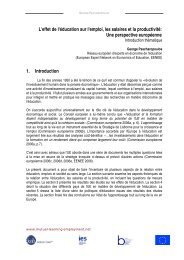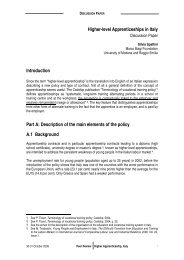The Active Labour Market Policy Reform – The Second Wave
The Active Labour Market Policy Reform – The Second Wave
The Active Labour Market Policy Reform – The Second Wave
Create successful ePaper yourself
Turn your PDF publications into a flip-book with our unique Google optimized e-Paper software.
May 13-14, 2004<br />
EXECUTIVE SUMMARY<br />
government has reacted with a comprehensive cross-governmental Age Programme (also<br />
subject to a Peer Review in 2000 1 and 2003 2 ).<br />
<strong>The</strong> labour market reforms are taking place in an overall context of reform in Finland. <strong>The</strong><br />
Finnish welfare state is undergoing a restructuring process, e.g. new ways of providing<br />
services jointly with the municipalities, the PES and the SII (??) have been established with<br />
the aim of achieving better co-operation and synergies. <strong>The</strong>re has been a shift in the<br />
steering mechanisms used in the public sector for governance and a move away from the<br />
‘management by objectives’ model of the 1980s and 1990s towards more heterogeneous<br />
models. <strong>The</strong>se include quality award elements, balanced scorecard approaches,<br />
benchmarking, and knowledge management.<br />
<strong>The</strong> Finnish <strong>Labour</strong> <strong>Market</strong> <strong>Policy</strong> System<br />
Finnish labour market policy is based on a broad range of services mainly focusing on jobbroking<br />
services, training measures and subsidised employment programmes. It also<br />
provides a large amount of information on vacancies, education and training, and careers.<br />
<strong>Labour</strong> <strong>Market</strong> <strong>Policy</strong> <strong>Reform</strong>s in the 1990s<br />
During the recession at the beginning of the 1990s, labour market policy took on a rather<br />
reactive role. As demand in the open labour market collapsed, active labour market policy<br />
programmes were stepped up to provide unemployed people with new qualifications and<br />
keep them job-ready. While these programmes helped interrupt individual periods of<br />
unemployment, they also had the effect of encouraging people to wait for activation rather<br />
than actively searching for a job themselves and thus actually prolonging the real period of<br />
unemployment.<br />
<strong>The</strong> first wave of the reforms, known as ‘activation and individual employment services’, was introduced<br />
in 1998. <strong>The</strong> main pillars of the reforms were:<br />
1) improved and more individual employment services,<br />
2) activation of the passive labour market support benefit for job-creation,<br />
3) reform of active programmes,<br />
4) reform of recruitment services and<br />
5) definition of the rights and obligations of the unemployed job-seekers.<br />
<strong>The</strong> employment services themselves were also reformed and their job-search remit increased.<br />
This involved skill-mapping to increase compatibility between vacancies and job-seekers and the<br />
introduction of large scale short-term job-search programmes for the unemployed, with the aim of<br />
reducing periods of unemployment. Efforts were also made to prevent exclusion from the labour<br />
market by reforming both the service process and the flat-rate unemployment benefit known as<br />
‘labour market support’.<br />
1 <strong>The</strong> National Programme for Ageing Workers (follow up), January 2003: http://www.peerreviewemployment.org/en/finland03/FIN03.htm;<br />
2<br />
<strong>The</strong> National Programme for Ageing Workers, October 2000: http://www.peerreviewemployment.org/en/finoct00.htm.<br />
Peer Review <strong>The</strong> <strong>Active</strong> <strong>Labour</strong> <strong>Market</strong> <strong>Policy</strong> <strong>Reform</strong> <strong>–</strong><br />
<strong>The</strong> <strong>Second</strong> <strong>Wave</strong><br />
2





